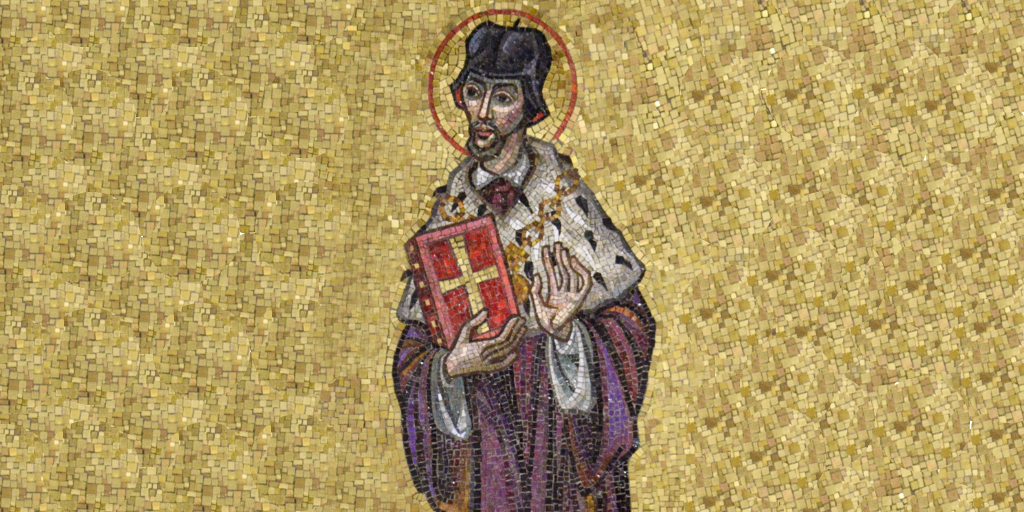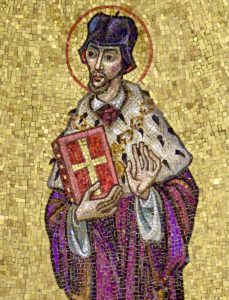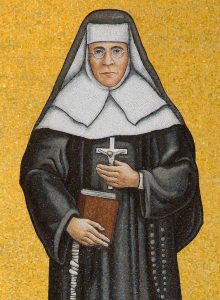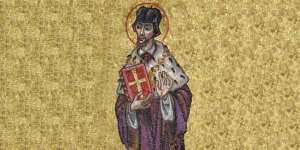
As we approach the start of the school year, we invite you to discover the stories of inspiring saints who were instrumental in furthering education. Whether they were founding schools for minorities or teaching the Scriptures, each of them significantly expanded educational opportunities in their communities and beyond. Above all, their care for students, love of learning, and love of God guided their lives.
1. St. Ciaran (Kiaran the Younger)

Born in 512, Ciaran was an Irish monk who had a passion for learning. He surrounded himself with a circle of dear friends including the scholar St. Finnian, St. Columba, St. Enda, St. Senan, and St. Kevin. His friendships followed the Celtic tradition of “soul friends” – close relationships where spiritual counsel is continually sought. One of these soul friends, Enda, received a similar vision to Ciaran when he was visiting him in Inishmore: near a river in the center of Ireland, both saw a great tree rise up whose branches spread out over the land and shielded it. From every corner of the earth, birds flocked to take its fruit back to their homes. Enda believed the vision to be a prophecy about Ciaran’s destiny in promoting education: the tree by the river represented Ciaran, whose monastic learning center would also be established near the river – and the birds represented the sundry scholars who would come from afar to learn there.
When Ciaran came home, he started to build a monastic learning center on the Shannon River in Clonmacnoise. Tragically, he passed away less than a year later – leaving Kevin and his other friends to finish his seminal work. The monastery in Clonmacnoise went on to become what scholar Dr. Tom Cowan calls “the most important learning center in the early medieval world.” You can find St. Ciaran portrayed in the Basilica in the Ave Maria Chapel.
2. St. John Cantius

A man of humble origins, John was born in the Polish town of Kenty in the early 1400s. After showing himself to be a talented student at his local school, John continued his studies at the Academy of Krakow. During his time there, John became not only an apt scholar, but a kindhearted and godly man. As he excelled, he found himself drawn to the study of philosophy and theology, eventually graduating with a doctorate.
Soon after his graduation, John was ordained as a priest. Rather than serving in the Church, John felt called to be a professor of theology at his alma mater. However, John’s tenure did not last long, as fellow professors grew jealous of how popular he became with the students, and falsely accused him of wrongdoing. Without even giving him a chance to defend himself, the school leaders sent him to serve as a parish priest at the town of Olkusz. Years later, when the charges were proved invalid, he was called to resume teaching at Krakow.
Once he returned to the Academy of Krakow, John served as the professor of Sacred Scripture, a position he held for the remainder of his life. Despite all the ill will he had suffered at the school, he did not behave self-righteously, but forgave those who wronged him, and acted with humility. He gave most of his earnings to others in need, keeping only a small amount for clothing and food. Above all, John always acted with a meek heart. Not only did he provide a faithful example of humility to those around him, but he encouraged his students to live lives of kindness and generosity.
3. St. Katharine Drexel

Saint Katharine Drexel was the second American-born saint to be canonized and is known for her commitment to racial justice and her educational efforts for minority groups in America. Katharine was born into an affluent Philadelphia banking family in 1858. During her family’s travels across the western United States, Katharine was struck by the poor living conditions endured by Native Americans on reservations. She decided to use her inheritance to establish the Sisters of the Blessed Sacrament in 1913. She was an unflagging advocate for minorities, crusading for better educational opportunities and standing against racial discrimination and injustice. In 1894, she opened the first mission school for Native Americans in New Mexico, and in 1915, she founded Xavier University, an institution of higher learning for African Americans in New Orleans.
By the start of World War II, she had founded schools for African Americans in 13 states, and 50 schools for Native Americans in 16 states. Katharine lived to be 97, and was canonized in 2000. She is the patroness of racial justice and philanthropists and is portrayed in the Hall of American Saints, the Trinity Dome, and the Crypt Church sacristy.
4. St. Angela Merici

The founder of the Order of St. Ursula, St. Angela Merici was born in Italy in 1474. After losing her parents and sister at a young age, she joined the Third Order of St. Francis, pledging herself to Christ. When she returned to her hometown of Desenzano at age 20, she was struck by the aimlessness of so many of the young women there. Few had received an education, and many struggled to find purpose. Their plight weighed on Angela’s heart, and she soon realized she needed to act. She began a variety of educational initiatives, first by opening her own home and then founding schools in Desenzano and Brescia.
In 1535, she created a teaching order under the patronage of St. Ursula, beginning with 12 young women. Called Angela’s Company of Saint Ursula, or the Ursulines, it was a “secular institute” – a group of women consecrated to Christ, but living in the world as opposed to a monastery. It was also the first teaching order of women in the Church. Though the members of the organization wore no formal habit or took vows, they held to a “Rule of Life” written by Angela that included a pledge to celibacy, poverty, and obedience. Throughout all the Ursulines’ pursuits, Angela’s goal was to improve the lives of families through the education of future wives and mothers. Today, the Company of St. Ursula continues Angela’s mission of education, with members in 30 countries around the world.
Sources:
Butler’s Lives of Saints, ed. Bernard Bangley.
“Saint Angela Merici,” Catholic News Agency.
“Saint Angela Merici,” Catholic Online.
“Saint Angela Merici, Franciscan Media.
“St. John Cantius,” New Advent.
“St. John of Kanty,” Catholic Online.
The Way of Saints, Dr. Tom Cowan.

